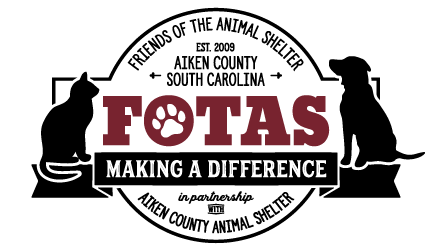By Joanna D. Samson, FOTAS Vice President.
When the Aiken County Animal Control officer picked up the scrawny yellow dog roving the County roads, they were taken aback by his condition. His left eye was damaged. His coat was dull and matted. He had lost patches of hair all over his body, revealing irritated, scabby skin underneath. He was hungry and dehydrated. He had no collar and no microchip.
At the Shelter, Dr. Levy examined the frightened stray, and hard as it is to imagine, his condition was worse than it appeared. His left eye had collapsed. He was infected with Demodectic mange. He was heartworm positive. Under normal circumstances, the combination of these three costly and chronic medical problems, coupled with his overall bad health, might have led Dr. Levy to conclude that it was more humane to end his suffering – after all, the Shelter must care for close to 5000 animals a year, and it is difficult enough to find the resources to care for the healthy ones.
But the plight of the scrawny yellow dog tugged at Dr. Levy and the staff’s heartstrings. Although shy at first, he was affectionate, desperate to please, and even more desperate to be loved. Everyone– Dr. Levy, the Shelter staff, and FOTAS—agreed this dog needed to be saved. So when no one claimed him after the mandatory 5-day hold, we named him Seamus (pronounced Shaa-mus) and set about to save his life.
First, Dr. Levy surgically removed Seamus’ collapsed left eye. He came through surgery like a champ.
Second, the Shelter began treating Seamus’ Demodectic mange, which is the non-contagious form of mange that can be cured with daily medication for 60-90 days.
Finally, although Seamus tested positive for heartworms, because of his age (Dr. Levy estimates he still young, probably about a year old), it is unlikely that the heartworm microfilaria (the heartworm larvae spread through the bite of a mosquito) has had an opportunity to develop into advanced heartworm disease.
Accordingly, Dr. Levy concluded that Seamus’ heartworms could be treated through the “slow kill” method, which involves administering an initial course of antibiotics, followed by monthly ivermectrin (HeartGuard), which is the same oral medicine every southern dog should take to prevent heartworms.
The Shelter and FOTAS have provided the resources to restore Seamus to good health, but his ultimate recovery depends upon you, the community.
Seamus desperately needs to recover in a home environment, because the inevitable stress of life in a crowded, public shelter will exacerbate his mange and compromise his immune system. Ideally, a forever home would be best. Short of that, if someone could foster him until he finds a forever home–that will work, too. The Shelter will provide his mange medicine and regular checkups, and FOTAS will pay for his heartworm treatment for 6 months.
Please, help us find the sweet, shy, 1-year-old, 45-pound Seamus a place to live, a home, and people to love him and care for him – all the things he deserves, but never had.
His life is in our hands.


